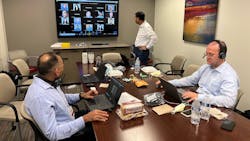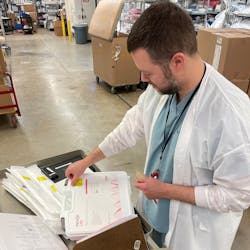UChicago Medicine’s Supply Chain team shares mindsets, motivations for success within their West Coast organization
The Supply Chain & Support Services team at UChicago Medicine fortifies and supports a healthcare haven inside a bustling urban metropolitan area. Eric Tritch, who came to the organization from outside healthcare more than a dozen years ago and rose through the ranks to serve currently as Vice President, Supply Chain & Support Services, shares with Healthcare Purchasing News Senior Editor Rick Dana Barlow what, how, and why they do what they do to operate as an award-winning enterprise.
HPN: What’s the secret formula that makes a leader in supply chain management? How does your department implement that secret formula?
The next big trend in healthcare supply chain management will be...[fill in the blank]. Why?
There is a lot of excitement around the capabilities of infrastructure, light robotics, and AI capabilities around data to build more actionable control tower solutions. The costs of these technologies continue to decline, and the ease of implementation is growing. Organizations that can effectively layer these into their operations will stay ahead of the curve when it comes to focusing on the meaningful work that engages staff and supports the true value of human talent, versus having staff to do tedious data or physical tasks that we often get stuck doing today.
Some in the “C-suite” have criticized supply chain managers for being too technical and not strategic enough to “join their club.” Do you agree? How might supply chain’s pandemic response contribute to the viewpoint(s)? Why?
It can be difficult when the supply chain is on fire to pause to be strategic. It takes enough layers and players to ensure the execution is happening, and to avoid burnout by strategizing in the midst of so much urgent activity. That said, it is essential for supply chain leaders to be a part of strategic planning efforts. Supply Chain is an integral part of all things non-labor-related, and has stepped into key support functions around labor as well (agency contracting, recruiting tools and services, etc.). Progressive C-suite leaders know that engaging key leaders and functions around both the development and the execution of the strategic vision are critical, and Supply Chain can’t be ignored in that capacity. It was very evident how critical the supply chain is during the pandemic, when CEOs and board members were getting regular updates from the Supply Chain team on inventory levels and sourcing strategies.
How can consulting firms, distributors and GPOs contribute to the performance of your internal supply chain management expertise without overshadowing the department or usurping control?
Effective supply chain leaders know how to develop and focus on their own internal core competencies and know when they need the help of external partners or experts. Sometimes, based on the size of your organization, it doesn’t make sense to carry to the internal expertise on every topic or category, and there also may not be enough activity/volume in a particular category or one-time event like implementing a new cloud ERP solution to allow for a broad experience set in-house. In these situations, you need a strong network of external experts you can tap into that produce a strong ROI when needed. In Chicago, we are tight on space and real estate on our campuses but are lucky to have a vast network of warehousing and distribution operations to tap into being one of the key intersections of transportation and logistics for the country. It is important to keep aware of what is going on externally, to avoid overspending or reinventing something that isn’t a core competency.
What specific project did your department complete where you felt they exceeded your expectations?
In your opinion, what is your department’s toughest administrative challenge? How might you solve it?
One of the toughest administrative challenges in supply chain is maintaining the appropriate balance of initiatives and improvement efforts while maintaining daily operations. We are still working on how to most effectively measure work product and labor utilization, especially in leadership and non-operations areas. We’ve done a good job at bending our top-line labor cost curve looking at our total supply chain labor cost as a percent of total supply chain spend, but we do still struggle with burnout by driving so hard on a number of major initiatives and keeping up with the state of the global supply chain. We work to ensure we have a strong employee engagement effort that takes seriously the health and wellbeing of our teams, from front line to senior leadership. We need to keep everyone sharp and engaged and focused on the mission and to have each other’s backs when needed. We push each other to take time off and need to model this for our teams. We also have regular senior leadership sessions to plan and guide our efforts to improve on these fronts and look for external partner support when warranted.
What is your department’s toughest operational challenge? How might you solve it?
What are your top three priorities for the remainder of 2022 and for 2023?
The top three priorities for the remainder of 2023 and for 2024 are focused around stabilizing our ERP implementation and ensuring to maximize the value of that solution along with overall support of our digital health efforts. We want to drive new margin improvement efforts across our organization to help us hit our earnings targets to be able to fund our growth and investment strategies. And finally we want to support our new site growth by integrating and launching new site builds and acquisitions on time and on budget, while ensuring a consistent care experience at all of our locations, and maximizing investment and partnership in the communities that we serve.
How does the CEO view your department? Does he or she see it as a strategic function or a support service? What resources can the department count on and will they come every year – and not just in response to clinician complaints or crises like the pandemic?
Our CEO, Tom Jackiewicz, joined the organization in the last few years during the COVID-19 pandemic, coming from Keck Medicine at USC. Joining at a time like this allowed supply chain to be squarely on his radar in a positive way. We’ve been able to show our prowess and expertise as a leading team through efforts not only to ensure we kept supply disruptions from impacting care or volumes, but also by continuing to find ways to offset the impacts of supply inflation. We also have found other margin improvement initiatives that allowed us to turn back on the growth spigot sooner, while other systems had to curb volumes or cancel elective procedures due to both supply cost and availability issues. We are seen as a strategic partner, and when we need resources we typically get support because we show a clear ROI and have a track record of meeting – if not beating – our commitments.
What are some practical, common-sense ways that supply chain managers can keep patient satisfaction in mind as they’re performing their duties?
We really drive home with our team the important role we play in the patient experience – both directly by the how the supplies and services we source and deliver impact the patients and their families, but also indirectly by how a seamless supply chain experience for our clinical team can take away frustrations and tasks that force them to take focus away from care activities. When we look at our “Value Stream” map across supply chain and prioritize improvement efforts, we lay out a vision based on what adds value to the patient. Sometimes this is cost-related, but a lot of times it is something else, and keeping that front and center allows us to focus on the right work. We’ve all had some care at times so reflecting on our experiences, and those of the people we care about, helps us think about what was great and not-so great and how we might make it better for our patients.
About the Author
Rick Dana Barlow
Senior Editor
Rick Dana Barlow is Senior Editor for Healthcare Purchasing News, an Endeavor Business Media publication. He can be reached at [email protected].




